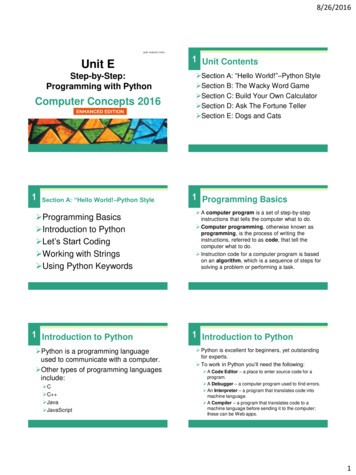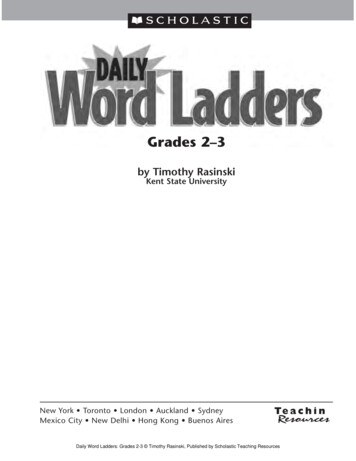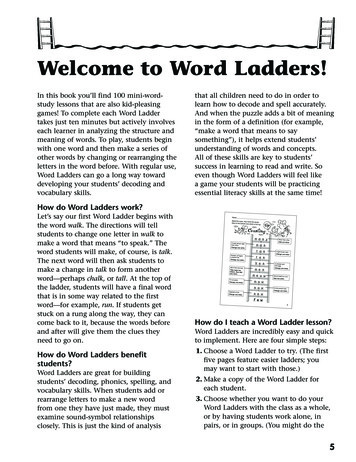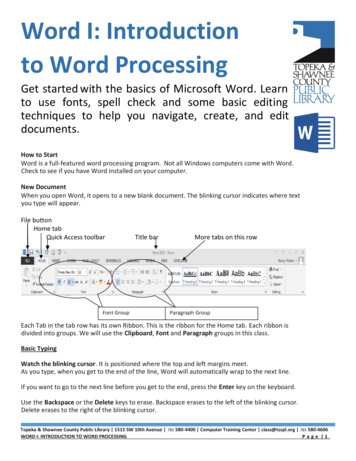
Transcription
8/26/2016Unit EStep-by-Step:Programming with PythonComputer Concepts 2016ENHANCED EDITION1Section A: “Hello World!–Python Style Programming Basics Introduction to Python Let’s Start Coding Working with Strings Using Python Keywords1 Introduction to Python Python is a programming languageused to communicate with a computer. Other types of programming languagesinclude: C C Java JavaScript1 Unit Contents Section A: “Hello World!”–Python Style Section B: The Wacky Word Game Section C: Build Your Own Calculator Section D: Ask The Fortune Teller Section E: Dogs and Cats1 Programming Basics A computer program is a set of step-by-stepinstructions that tells the computer what to do. Computer programming, otherwise known asprogramming, is the process of writing theinstructions, referred to as code, that tell thecomputer what to do. Instruction code for a computer program is basedon an algorithm, which is a sequence of steps forsolving a problem or performing a task.1 Introduction to Python Python is excellent for beginners, yet outstandingfor experts. To work in Python you’ll need the following: A Code Editor – a place to enter source code for aprogram. A Debugger – a computer program used to find errors. An Interpreter – a program that translates code intomachine language. A Compiler – a program that translates code to amachine language before sending it to the computer;these can be Web apps.1
8/26/20161 Introduction to Python An IDE (integrated development environment)provides an editor, debugger, and interpreter. The programs in Unit E use the online IDE repl.it.1 Let’s Start Coding You can modify your program using the codeeditor. Figure E-3 shows the modified “HelloWorld!” program.1 Let’s Start Coding The Python programming language has its ownsyntax, which is a set of rules that defines how itcan be written. A comment in Python is used by programmers toexplain what the code does–it does not show upwhen the program runs. An important rule to remember is that a commentmust begin with the # character and end on thephysical line on which the # character has beentyped.1 Let’s Start Coding The most famous program in the world is a singleline of code that prints “Hello World!” on the screen. After entering and running the “Hello World!”program, your program and output should look likeFigure E-2.1 Let’s Start Coding Most programs contain more than one line ofcode. The example below in Figure E-4,demonstrates how to write a multiline“KnockKnock” joke in Python.1 Working with Strings When you write a sentence, you create a sequenceof words that your reader will understand. Similarly,in programming you create a sequence ofcharacters called a string, which can be made upof words, letters, punctuation marks, and numerals. For example, in your first program, line 2 containsthis string:2
8/26/20161 Working with Strings The term concatenation is used by programmersany time two or more characters are connected. Several strings can be connected using a symbol,such as the symbol, as a concatenationoperator. The example below uses the symbol toconcatenate two strings:1 Using Python Keywords All programming languages have their ownvocabulary, which is based on a set of keywords.Python has a small vocabulary of only 33 keywords,of which only about 10 are frequently used.1 Debugging A syntax error occurs when an instruction does notfollow the rules of the programming language. Some Python syntax rules are: Comments always start with a #. Python is case sensitive. Strings are delineated by quotation marks. Keywords can only be used for their intendedpurpose.1 Working with Strings Python gives programmers a shortcut for workingwith repeated strings. To print the same word morethan once, just use the * symbol and the number oftimes you want it duplicated. Figure E-5 shows whatyour output should look like.1 Debugging Programs must be tested to see if theywork correctly. A programming error iscalled a bug. The process for tracking down bugs andcorrecting them is called debugging. Syntax errors and logic errors are thetwo most frequently encountered.1 Debugging If you receive an error message you can check theline of code where the error resides. Figure E-7 shows an error message generated inPython. Read the message carefully to identify yourerror.3
8/26/20161Section B: The Wacky Word Game Using Variables Objects and Classes Input Wacky Word Game Sharing Your Programs1 Using Variables1 Using Variables Technically, a variable is a named memory location thatholds data specified by a programmer or entered by an enduser. Programmers think of variables as empty boxes where datacan be temporarily stored and used by a computer program.1 Using Variables A variable name should describe the information thevariable is designed to store. For example, a goodname for a variable that will contain a first namemight be “firstname” or “first name.”1 Using Variables The process of creating a variable is sometimesreferred to as declaring a variable. Putting data in a variable is referred to as assigninga value to it.1 Using Variables The type of data that a variable can holdis referred to as its data type.4
8/26/20161 Objects and Classes Python is an object-oriented programminglanguage, which is a language that enables theprogrammer to use objects to accomplish aprogram’s goals. The object-oriented paradigm is based on objectsand classes that can be defined and manipulated byprogram code. Object-oriented programming (OOP) is a style ofprogramming that focuses on using objects todesign and build applications.1 Objects and Classes1 Objects and Classes An object is anything that can be seen, touched, orused; it can be a person, a place, or a thing. Every object in an OOP is crated from a class,which is a description or template that the computeruses to create the object. A class attribute defines the characteristics of aset of objects. An object created from a class is called an instanceof a class and is said to be instantiated (created)from the class.1 Input Python uses the input command to get user input. The input command allows the program to display amessage on the screen that asks a user to enterinformation; this message is called a prompt. For example, suppose you want a program togather a user’s name. You could write the followingcode:1 Input Writing prompts using the input command is a greatway to relay instructions to your program’s user.Figure E-17 demonstrates how to use the inputcommand in your code.1 Wacky Word Game The Wacky Word Game uses variables, strings, and input.This program produces a game that prompts a player for alist of words and then asks the player to use them in astory or a poem. The output generates a nonsensical orcomical story.5
8/26/20161 Sharing Your Programs You may want to share your programcode with your friends, instructors, etc. To do so, you can use repl.it’s Shareoption. You can also make a screenshot of theprogram and share it as a file.1 Calculations1Section C: Build Your Own Calculator Calculations Selection Structures Comparison and Logical Operators Comparing Strings1 Calculations When a computer calculates an arithmetic operationit is called computation. To instruct the computer to perform a calculation,programmers use an arithmetic expression, whichcontains values (such as 2 and 3) and arithmeticoperators (such as and -). Figure E-19, on the next slide, illustrates a simplearithmetic expression and the symbols Python usesfor arithmetic operators.1 Calculations The result of an arithmetic expression depends on the orderin which Python performs the math. In mathematics, the order of operations is a collection ofrules that dictate which procedures to perform first whencalculating an arithmetic expression. In Python, the order of operations follows these rules:1 Calculations Programmers frequently set up calculations by loadingvalues into variables and then writing formulas usingvariables instead of numbers. This technique makes it easy to modify the numbers used ina calculation or get the numbers as input when a programruns. Figure E-20 shows a program with the variables “price” and“discount.”6
8/26/20161 Selection Structures A selection control structure tells a computer what to dobased on whether a condition is true or false. You can think of a selection control as one or more paths ina program. Figure E-24 illustrates a simple branch using a checkedbags example.1 Selection Structures Frequently, programmers want one thing to happenwhen a condition is true and something else tohappen when it is false. To accomplish this, they use the if else statement. Figure E-26 illustrates how to program an if elsestatement about weather conditions and clothing.1Comparison and Logical Operators The operator is the equality operator; it is used forcomparisons. The symbol is the assignment operator; it is used to storevalues and strings in variables. Two rules come in handy when using comparisonoperators: First rule: If an expression contains more than one comparisonoperator, the operators are evaluated from left to right in theexpression. Second rule: Comparison operators are evaluated after anyarithmetic operators in an expression. For example, in 3 6 16 / 2,the two arithmetic operators will be evaluated first, and then the tworesulting numbers will be compared.1 Selection Structures An example of a selection control structure is the ifcommand. Figure E-25 illustrates how an if statement works ina program using the airport kiosk checked bagexample from Figure E-24.1Comparison and Logical Operators A comparisonoperator is used inan expression tocompare twovalues. The most commonlyused comparisonoperators are , and .1Comparison and Logical Operators If else statements can also containlogical operators. Python has three logical operators:AND, OR, and NOT. Python evaluates logical expressions astrue or false, so they can be the basisfor control structures that use ifstatements.7
8/26/20161 Comparing Strings When a program collects string input, such as a user’sname, it can be used in expressions that become part ofcontrol structures. For example, a program might ask users if they know how toswim in order to enroll them in the appropriate swim class. Strings in Python are case sensitive, which means the string“Yes” is not the same as either the string “YES” or the string“yes”. To avoid problems with case, you can use the upper() andlower() methods to convert string input to a known case.1 Repetition Control Structures A repetition control structure allows programmers towrite code that can repeatedly execute a statementor a series of statements. The section of code that repeats is referred to as aloop or an iteration. Python has two types of loops: the for-loop and thewhile-loop. For-loops make it easy to specify the number ofrepetitions in a loop.1 Lists Lists are tools that programmers use to makecertain programming tasks straightforward whencombined with repetition. Lists can be used for mathematical operations, suchas totaling the items in a list and placing the resultin an accumulator. An accumulator is a numeric variable in whichvalues are repetitively added.1Section D: Ask The Fortune Teller Repetition Control Structures Lists1 Lists A list in Python is an ordered group ofitems that can be numbers or stringsthat are modifiable. The following are some examples oflists:1 Section E: Dogs and Cats Functions Methods8
8/26/20161 Functions1 Functions In this Unit, you have used several of Python’s builtin functions, such as print(), input(), and str(). A programmer-defined function is typically a blockof code that is part of a program but is not includedin the main execution path. Figure E-42, on the next slide, illustrates how aprogrammer would visualize the structure of aprogram containing the treasure chest() function.1 Functions When using functions, keep the following in mind: Function blocks begin with the keyword def followed bythe function name and parentheses (). The parentheses can hold parameters. Make sure thatthe function call and the function definition have the samenumber of parameters. The code block within every function starts with a colon (:)and is indented. The function terminates with the last indented line ofcode. The return statement passes data from the function to themain program.1 Methods1 Methods A method is a segment of code that defines anaction belonging to a class. In Python, methods are essentially functions, butthey are defined slightly differently; a method mustalways have an argument called self within theparentheses. When Python calls a method, it passes the currentobject to that method as the first parameter. Figure E-48, on the next slide, illustrates how thisworks.1 Methods In object-oriented jargon, inheritance refers to passingcertain characteristics from one class to other classes. A superclass is the class from where attributes andmethods can be in inherited. A subclass inherits attributes and methods from asuperclass. Polymorphism, sometimes called overloading, is the abilityto redefine a method in a subclass. It enables programmersto create a single, more generic name for a method thatbehaves in unique ways for different classes.9
8/26/2016Unit E CompleteComputer Concepts 2016ENHANCED EDITION10
1 Let's Start Coding Most programs contain more than one line of code. The example below in Figure E-4, demonstrates how to write a multiline"Knock Knock" joke in Python. 1 Let's Start Coding The Python programming language has its own syntax, which is a set of rules that defines how it can be written.










